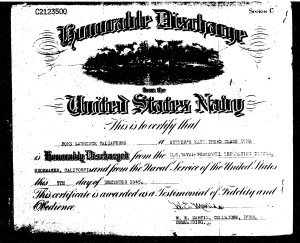 My father, John Lawrence Taliaferro, served in the Navy during World War II. He entered active service on 16 July 1942, in Macon, Georgia and was honorably discharged from the U. S. Naval Personnel Separation Center in Shoemaker, California on 5 December 1945. What a great Christmas present for his family who I am sure prayed for his safe return.
My father, John Lawrence Taliaferro, served in the Navy during World War II. He entered active service on 16 July 1942, in Macon, Georgia and was honorably discharged from the U. S. Naval Personnel Separation Center in Shoemaker, California on 5 December 1945. What a great Christmas present for his family who I am sure prayed for his safe return.
I know from my mother that she met my father, shortly after his discharge. My mom told me that when she met my father, he was wearing his Navy uniform. Maybe he was celebrating – happy to be home from the war. That was the only story I had that placed my father in the military. In 2006, my cousin gave me his discharge paper, and from that I pieced together more details about his service in the Navy.
My father held several ratings during service including, AS S2c, S1C, and GM3c. I believe the “S” rating stands for Seaman. The GM is for Gunner’s Mate. I learned that Gunner’s Mates are responsible for the operation and maintenance of guided missile launching systems, gun mounts and other ordnance equipment, as well as small arms and magazines.
On his discharge paper under “Qualifications and Certification Held” is Driving Winch, Checking Ammunition; under “Service (vessels and stations served on)” USNB Nav. Mag. Port Chicago, Calif,- USNB NAD, Mare Island, California, and USNAD, Navy # 66; and under “Remarks” Asiatic-Pacific Theatre, Victory Medal, American Theatre, and Point System.
Obviously, my father completed his tour of duty, and made it home safely. Historically, however, things could have been quite different.
********************
The Port Chicago Disaster
America was swept into World War II on 7 December 1941. As war in the Pacific expanded, the Naval Ammunition Depot at Mare Island, California, was unable to keep up with the demand for ammunition. Port Chicago, California, located 35 miles north of San Francisco, proved an ideal place for the Navy to expand its munitions facilities. Construction at Port Chicago began in 1942. By 1944, expansion and improvements to the pier could support the loading of two ships simultaneously.
African-American Navy personnel units were assigned to the dangerous work at Port Chicago. Reflecting the racial segregation of the day, the officers of these units were white. The officers and men had received some training in cargo handling, but not in loading munitions. The bulk of their experience came from hands-on experience. Loading went on around the clock. The Navy ordered that proper regulations for working with munitions be followed. But due to tight schedules at the new facility, deviations from these safety standards occurred. A sense of competition developed for the most tonnage loaded in an eight hour shift. As it helped to speed loading, competition was often encouraged.
On July 17, 1944, a deadly munitions explosion occurred at the Port Chicago Naval Magazine in Port Chicago, California. Munitions detonated while being loaded onto a cargo vessel bound for the Pacific Theater of Operations, killing 320 sailors and civilians and injuring 390 others. Most of the dead and injured were enlisted African-American sailors; Of the 320 men killed in the explosion, 202 were the African-American enlisted men who were assigned the dangerous duty of loading the ships. The explosion at Port Chicago accounted for fifteen percent of all African-American casualties of World War II.
Source: Naval History & Heritage Command, Navy Department Press Releases, July 16-31, 1944 folder, Box 55, World War II Command File, Operational Archives Branch, Washington, DC. http://www.history.navy.mil/faqs/faq80-1.htm assessed 8 May 2010.
*******************
What does all this mean? Exactly what did my father do while in the Navy during World War II? Honestly, I don’t really know. As a Gunner’s Mate he was definitely involved with ammunition. Was he involved in the Port Chicago incident? It’s very likely. I know he served on vessels during several major campaigns, the Asiatic Pacific Theatre, and the American Theatre. He also received the Victory Medal which “may be awarded to all members of the Armed Forces of the United States or of the Government of the Philippine Islands who served on active duty in World War II at any time between 7 December 1941 and 31 December 1946.” (Established by Public Law No. 135 of 6 July 1945.) Source: U.S. Navy Awards Manual, 1953.
My father, John Lawrence Taliaferro, was discharged on 5 December 1945. He served in the Navy for 3yrs, 4 months, 19 days. On his discharge paper under “Character of Separation is “Honorable EE”. While I don’t know the specifics of my father’s service in the Navy, I’d like to think he served his country to the best of his ability, and that he served with pride. I’d like to think that my father, John Lawrence Taliaferro, Gunner’s Mate Third Class, USNR, Served with Honor.


